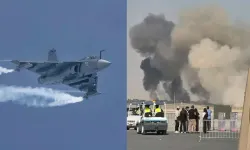In recent weeks, the discovery of two large clusters of ballistic missile silos in western China forced observers to dramatically increase their estimates of China’s number of ICBM silos and even rethink beliefs about Beijing’s nuclear strategy. But this dramatic imagery—notably, captured by commercial satellites—is only the most visible part of a larger growth.
Until recently, the PLA Rocket Force had been known to maintain about 20 silos for its liquid-fueled DF-5 ICBMs. In late June, analysts at the James Martin Center for Nonproliferation Studies discovered about 120 more silos in a remote part of Gansu Province. This alone was huge news, representing a sudden six-fold increase. About four weeks later, analysts at the Federation of American Scientists announced the discovery of a second such area of almost equal size, this one located in a remote part of Xinjiang, about 240 miles from the small city of Hami. The second site is in an earlier stage of construction but appears large enough to eventually house about 110 silos. This puts the count at around 230, a more-than-ten-fold increase in the number of silos across an incredibly short period of time.
Naturally, this news sparked an outpouring of analysis of China’s intentions and whether this means an end to its longstanding policy of minimum deterrence. There is a caveat, however: we currently have no way to know how many of the silos will be filled with actual missiles, nor how many warheads each missile will carry. It is unlikely that all, or even most, of the silos will be filled, at least for the time being, given limitations on China’s stockpile of fissile material. And even if they were, it would not fundamentally challenge the strategic balance with an American nuclear arsenal that is still many times its size. One possible conclusion is that the PLA Rocket Force may be executing a kind of “shell game”: filling only some of the silos and perhaps moving the missiles periodically. This would force an adversary to expend resources targeting every silo.
While the focus of media attention has been on the sheer number of new silos, other aspects of China’s significantly expanded and modernized ballistic missile force are less visible but equally important.
The first is how these silo fields might affect the PLARF’s force structure and order of battle. Since the 1960s, the PLARF (or, before 2016, the 2nd Artillery), has consisted of six operational Bases, each overseeing several brigades stationed across a wide geographic area. In the PLARF, a capital-B “Base” refers to a discrete unit within the PLA organizational structure, the same as a regiment, brigade, or division, in this case, a Corps or Corps-Deputy strength organization. Each designated Base may in turn oversee several lowercase “bases,” that is, a generic term for a physical location housing military forces.
As we previously reported, the PLARF exploded in size between 2017 and 2019, growing more than 33 percent in only three years. Ten new brigades were added, with the six Bases growing to accommodate them.
However, the construction of two entirely new missile silo fields could make that existing structure inadequate. Assuming roughly six to 12 silos for a typical ICBM brigade, each field could easily require multiple brigades, even if only a fraction of the silos were filled.
Currently, all PLARF Bases oversee between six and seven brigades and seem unlikely to grow much further. This means that each of these sites would likely be too large to fit within the existing force structure and could easily become a Base in its own right. This would make them the PLA’s first new ballistic missile Bases in over 50 years.
Source: defenseone







